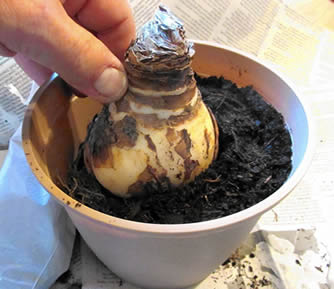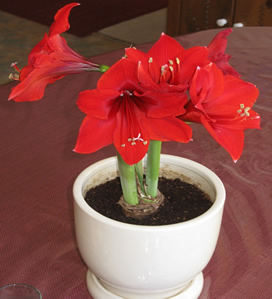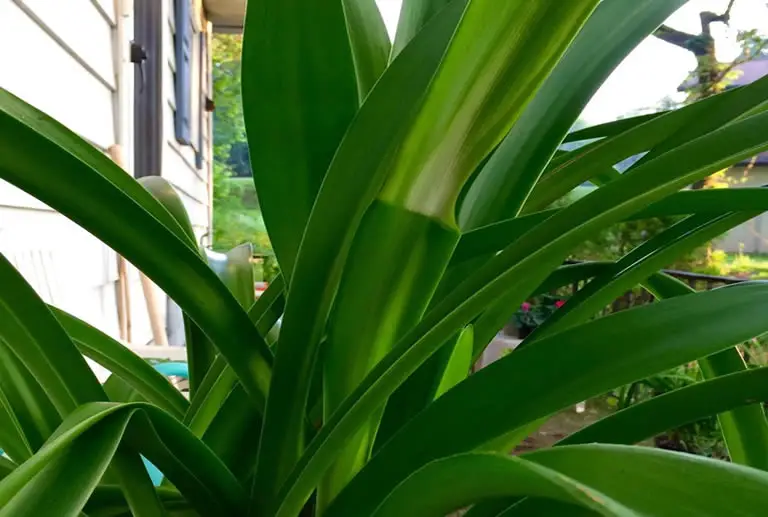Amaryllis is a great succulent to grow as a houseplant. It is an easy-care plant that requires very little attention other than regular watering. But, many amaryllis owners encounter problems with the leaves of this tropical plant. Let’s take a look at several common problems associated with amaryllis leaves and identify the cures.
Table of Contents
Why your amaryllis has no leaves
What happens if you have an amaryllis plant that has no leaves? Is there a potential problem with the plant that requires attention?
It is normal for amaryllis to lose all its leaves before it enters a state of dormancy.
The amaryllis bulb will rest for about 2 months before producing new leaf growth.
The bulb does not need to moved to a dark place as it will continue to gather resources for its new growth cycle.
When an amaryllis plant starts to enter a period of dormancy the leaves will usually start to turn yellow and die.
This is nothing to worry about as an amaryllis bulb must be allowed to rest.
If the plant is forced to remain in a growth or blooming state it will have a major detrimental effect on the plant in the long-term.

An amaryllis bulb, unlike many other plant types, does not require darkness to rest.
Even during its dormancy state the bulb will continue to gather resources for use in its next growth stage.
However, even though the bulb continues to gather resources you should not fertilize the plant.
Fertilizing an a amaryllis when the bulb is entering dormancy, once it starts to lose its leaves, will almost always force the plant into a new growth cycle and this will overwork the bulb.
With each progressive stage of growth the plant will produce weaker foliage and less vibrant blooms, if it even blooms at all.
During dormancy the bulb will also not require the same level of regular watering, when it has no leaves, that it needs when it is in its growth and blooming period.
In fact, you will probably not need to water the plant at all during the dormancy phase because the plant obviously does not require much water while the bulb rests.
Dormancy usually last 2 months but in some cases can be closer to 3 months.
Do not allow the soil to completely dry out, but you should avoid allowing the bulb to sit in very damp soil as it can lead to root rot during dormancy.
Unless your home is kept very warm, or the area in which the plant sits is very hot, it is unlikely you will need to water the bulb at al.
Only continue a normal watering routine when you start to see new leaf growth.
Why your amaryllis has leaves but no flowers
What is the cause when your amaryllis has plenty of foliage but it refuses to produce any flowers?
One cause for an amaryllis having leaves but no flowers is forced reblooming.
Forcing the plant to rebloom when it should be entering a state of dormancy can lead to no flowers. Let the bulb rest.
Lack of nutrients in the soil is another cause for leaves but no flowers. Sit the plant in a bright spot.
Water it regularly and fertilize it every 2 weeks.
A healthy amaryllis that has nice deep green and upright leaves but no flowers could be suffering from a lack of nutrients.
It is important to ensure your amaryllis is getting enough nutrients and this starts with your choice of soil.
Unlike many other succulents which prefer a slightly acidic cacti soil, like hawthoria for example, amaryllis will thrive is a good nutrient-rich potting soil like this Miracle-gro potting mix.
Amaryllis also need plenty of water. During the growth and blooming periods of an amaryllis it is very important to water the plant regularly.
Unlike many succulents amaryllis, like aloe vera, requires regular watering. You should never let the soil of an amaryllis plant completely dry out.
Only the first 2cms of the top layer of the soil should be allowed to dry out before you water the plant.
Use the finger test to ascertain if the plant needs watered until you start to understand its watering needs.
Insert your finger into the soil up to the end of the first finger bone – the first bend in your finger.
This equates to a depth of roughly 2cms.

When you pull your finger out some soil residue should be on your finger. If nothing is on your finger then your plant needs watered.
Although its true that you can cultivate amaryllis in water you should avoid overwatering potted amaryllis as it will react poorly if it is forced to sit in waterlogged soil. Damp is good.
Waterlogged is bad. Read our amaryllis watering guide for more information.
As a succulent amaryllis loves the sun. If the plant doesn’t get enough sun it may produce leaves but it may not bloom.
So ensure you place the plant is a well lit area that gets plenty of sunlight.
For healthy flowers, as well as healthy leaves, during its growth and flowering stages you can fertilize your amaryllis every two weeks unless it is a newly potted plant in fresh potting mix because there will be more than enough nutrients in fresh soil.
If you have been trying to force your amaryllis to rebloom after it has already bloomed without proper nutrients in the soil then the plant is only going to producing leaves and no new flowers.
However, if you have been doing this regularly then please stop what you’re doing now.
Allow the bulb to rest.
Amaryllis bulbs need at least 2 months to rest and gather enough resources to ensure healthy new future growth and vibrant blooms.
If you don’t allow the bulb to rest it will become overworked and the plant will become incapable of flowering.
There are key steps that need to be followed to ensure an amaryllis will rebloom without damaging the plant that involves removing the bulb and refrigerating it, among other things.

Simply forcing amaryllis to rebloom while it remains potted will lead to plant damage.
When you allow amaryllis to follow its own growth, blooming and rest cycle there is no need to move the bulb when it goes into dormancy because, unlike many other plants, an amaryllis bulb can happily sit in sunlight while it rests.
Even in dormancy the bulb will continue to gather resources for its next growth stage.
Do not fertilize the plant when it is entering dormancy or you will prevent the bulb from resting which can lead to new leaf growth but no flowers.
Fertilizing amaryllis when the bulb wants to rest forces the plant into another growth stage and this will overwork the bulb.
If you do this you will end up with a sickly plant with faded leaf color, lackluster blooms (if it has any at all) and limp drooping foliage that leads to a plant that won’t stay upright (see this article).
When to cut back amaryllis leaves
The only time you will want to cut amaryllis leaves is if you are trying to get the plant to rebloom. It is not really in the best interest of the plant to cut it if you want it to remain healthy and vibrant for decades, as I have already covered above.
Amaryllis owners are often tempted to cut the leaves of their plant when they start to turn yellow but you should not do this.
When amaryllis leaves turn yellow the bulb is preparing to go dormant for a few months so it can rest and gather resources for its next growth cycle.
If you cut the leaves at this stage you will prevent the bulb from resting, and as I have already outlined earlier this will lead to a plant with sickly leaves and no flowers.
How to cut amaryllis leaves
If you are set on forcing your amaryllis to rebloom (I strongly advise you not to do this too often) then there is a set way to cut the leaves.
It is not advisable to cut amaryllis leaves as it prevents the bulb from resting.
However, to force reblooming cut amaryllis leaves back to the stem of the bulb after the plant has stopped producing flowers.
When the stem sags cut it back to the bulb. Water and fertilize to promote new growth.
Amaryllis will usually only bloom once per year. But, by cutting amaryllis leaves back to the bulb you can force the plant to rebloom.
After each rebloom you must remove the bulb from the soil and store it in a dark and cool area so it can rest for 6 weeks.
Failure to do this will really damage the plant and it simply will not flower.
It is ok to this this forced-reblooming occasionally, especially if you’d like a bi-yearly bloom, but I really don’t advise doing it any more regularly than that.
The amaryllis bulb really needs to be allowed to rest naturally and go dormant for at least 2 months if you want to keep the plant healthy and vibrant for many years to come.
Amaryllis can last decades when they are cared for properly. This is an easy-care plant, so you only need to maintain its watering routine and give it plenty of sunlight without messing with its natural growth and rest cycle.

